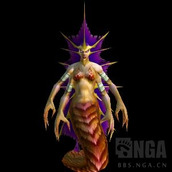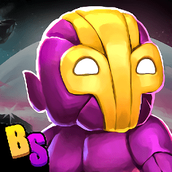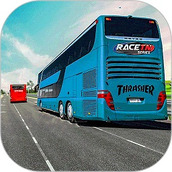Android自定义双向进度条的实现代码
作者:袖梨
2022-06-25
想整个双向的进度条,就是可以选取播放范围的。
像这样:
然而官方控件里只有单向的。不要慌,我们自己画一个。
绘制一个进度条主要是三方面。1.样式,2.尺寸,3.操作监听。
完整代码来一遍:
注释基本上就把原理说明了一下。
package util;
import android.content.Context;
import android.graphics.Canvas;
import android.graphics.Color;
import android.graphics.Paint;
import android.graphics.drawable.Drawable;
import android.support.v4.content.ContextCompat;
import android.util.AttributeSet;
import android.util.Log;
import android.view.MotionEvent;
import android.view.View;
import com.example.qzd.utildemo.R;
import java.math.BigDecimal;
/**
* 双向滑块的进度条(区域选择)
*/
public class SeekRangeBar extends View {
private Context _context;
private static final int CLICK_ON_LOW = 1; //手指在前滑块上滑动
private static final int CLICK_ON_HIGH = 2; //手指在后滑块上滑动
private static final int CLICK_IN_LOW_AREA = 3; //手指点击离前滑块近
private static final int CLICK_IN_HIGH_AREA = 4; //手指点击离后滑块近
private static final int CLICK_OUT_AREA = 5; //手指点击在view外
private static final int CLICK_INVAILD = 0;
private static final int[] STATE_NORMAL = {};
private static final int[] STATE_PRESSED =
{android.R.attr.state_pressed,android.R.attr.state_window_focused,};
private static int mThumbMarginTop = 0; //滑动块顶部离view顶部的距离
private static int mTextViewMarginTop = 0; //当前滑块文字距离view顶部距离
private Drawable hasScrollBarBg; //滑动条滑动后背景图
private Drawable notScrollBarBg; //滑动条未滑动背景图
private Drawable mThumbLow; //前滑块
private Drawable mThumbHigh; //后滑块
private int mScollBarWidth; //控件宽度 = 滑动条宽度 + 滑动块宽度
private int mScollBarHeight; //控件高度
private int mThumbWidth; //滑动块直径
private double mOffsetLow = 0; //前滑块中心坐标
private double mOffsetHigh = 0; //后滑块中心坐标
private int mDistance=0; //总刻度是固定距离 两边各去掉半个滑块距离
private int mFlag = CLICK_INVAILD; //手指按下的类型
private double defaultScreenLow = 0; //默认前滑块位置百分比
private double defaultScreenHigh = 100; //默认后滑块位置百分比
private OnSeekBarChangeListener mBarChangeListener;
private boolean editable=false;//是否处于可编辑状态
private int miniGap=5;//AB的最小间隔
private double progressLow;//起点(百分比)
private double progressHigh;//终点
public SeekRangeBar(Context context) {
this(context, null);
}
public SeekRangeBar(Context context, AttributeSet attrs) {
this(context, attrs, 0);
}
public SeekRangeBar(Context context, AttributeSet attrs, int defStyle) {
super(context, attrs, defStyle);
_context=context;
//这里设置背景图及滑块图,自定义过进度条的同学应该很熟悉了
notScrollBarBg = ContextCompat.getDrawable(_context,R.mipmap.hp_wbf);
hasScrollBarBg = ContextCompat.getDrawable(_context, R.mipmap.hp_ybf);
mThumbLow = ContextCompat.getDrawable(_context,R.mipmap.hp_a);
mThumbHigh = ContextCompat.getDrawable(_context,R.mipmap.hp_b);
mThumbLow.setState(STATE_NORMAL);
mThumbHigh.setState(STATE_NORMAL);
//设置滑动条高度
mScollBarHeight = notScrollBarBg.getIntrinsicHeight();
//设置滑动块直径
mThumbWidth = mThumbLow.getIntrinsicWidth();
}
/**
* 测量view尺寸(在onDraw()之前)
* @param widthMeasureSpec
* @param heightMeasureSpec
*/
protected void onMeasure(int widthMeasureSpec, int heightMeasureSpec) {
int width = MeasureSpec.getSize(widthMeasureSpec);
mScollBarWidth = width;
if(mDistance==0) {//这里滑块中心坐标初始化的时候测量一下(根据mDistance是否赋值判断),并不需要不停地去测量。后面会根据进度计算滑块位置。
mOffsetLow = mThumbWidth / 2;
mOffsetHigh = width - mThumbWidth / 2;
}
mDistance = width - mThumbWidth;
if(defaultScreenLow != 0) {
mOffsetLow = formatInt(defaultScreenLow / 100 * (mDistance)) + mThumbWidth / 2;
}
if(defaultScreenHigh != 100) {
mOffsetHigh = formatInt(defaultScreenHigh / 100 * (mDistance)) + mThumbWidth / 2;
}
setMeasuredDimension(width, mThumbWidth + mThumbMarginTop + 2);
}
protected void onLayout(boolean changed, int l, int t, int r, int b) {
super.onLayout(changed, l, t, r, b);
}
/**
* 绘制进度条
*/
protected void onDraw(Canvas canvas) {
super.onDraw(canvas);
//设置绘制样式
Paint text_Paint = new Paint();
text_Paint.setTextAlign(Paint.Align.CENTER);
text_Paint.setColor(Color.RED);
text_Paint.setTextSize(20);
int top = mThumbMarginTop + mThumbWidth / 2 - mScollBarHeight / 2;
int bottom = top + mScollBarHeight;
//绘制是否可操作状态的下的不同样式,仅可编辑状态下显示进度条
if(editable) {
//白色滑动条,两个滑块各两边部分
notScrollBarBg.setBounds(mThumbWidth / 2, top, mScollBarWidth - mThumbWidth / 2, bottom);
notScrollBarBg.draw(canvas);
//红色滑动条,两个滑块中间部分
hasScrollBarBg.setBounds((int) mOffsetLow, top, (int) mOffsetHigh, bottom);
hasScrollBarBg.draw(canvas);
}
//前滑块
mThumbLow.setBounds((int) (mOffsetLow - mThumbWidth / 2), mThumbMarginTop, (int) (mOffsetLow + mThumbWidth / 2), mThumbWidth + mThumbMarginTop);
mThumbLow.draw(canvas);
//后滑块
mThumbHigh.setBounds((int) (mOffsetHigh - mThumbWidth / 2), mThumbMarginTop, (int) (mOffsetHigh + mThumbWidth / 2), mThumbWidth + mThumbMarginTop);
mThumbHigh.draw(canvas);
//当前滑块刻度
progressLow = formatInt((mOffsetLow - mThumbWidth / 2) * 100 / mDistance);
progressHigh = formatInt((mOffsetHigh - mThumbWidth / 2) * 100 / mDistance);
canvas.drawText((int) progressLow + "", (int) mOffsetLow - 2 - 2, mTextViewMarginTop, text_Paint);
canvas.drawText((int) progressHigh + "", (int) mOffsetHigh - 2, mTextViewMarginTop, text_Paint);
if (mBarChangeListener != null) {
mBarChangeListener.onProgressChanged(this, progressLow, progressHigh);
}
}
//手势监听
@Override
public boolean onTouchEvent(MotionEvent e) {
if(!editable) {
return false;
}
if (e.getAction() == MotionEvent.ACTION_DOWN) {
mFlag = getAreaFlag(e);
if (mFlag == CLICK_ON_LOW) {
mThumbLow.setState(STATE_PRESSED);
} else if (mFlag == CLICK_ON_HIGH) {
mThumbHigh.setState(STATE_PRESSED);
} else if (mFlag == CLICK_IN_LOW_AREA) {
mThumbLow.setState(STATE_PRESSED);
mThumbHigh.setState(STATE_NORMAL);
//如果点击0-mThumbWidth/2坐标
if (e.getX() mScollBarWidth - mThumbWidth / 2) {
mOffsetLow = mThumbWidth / 2 + mDistance;
} else {
mOffsetLow = formatInt(e.getX());
}
} else if (mFlag == CLICK_IN_HIGH_AREA) {
mThumbHigh.setState(STATE_PRESSED);
mThumbLow.setState(STATE_NORMAL);
if (e.getX() >= mScollBarWidth - mThumbWidth / 2) {
mOffsetHigh = mDistance + mThumbWidth / 2;
} else {
mOffsetHigh = formatInt(e.getX());
}
}
//更新滑块
invalidate();
} else if (e.getAction() == MotionEvent.ACTION_MOVE) {
if (mFlag == CLICK_ON_LOW) {
if (e.getX() = mScollBarWidth - mThumbWidth / 2) {
mOffsetLow = mThumbWidth / 2 + mDistance;
mOffsetHigh = mOffsetLow;
} else {
mOffsetLow = formatInt(e.getX());
if (mOffsetHigh - mOffsetLow mScollBarWidth - mThumbWidth / 2) {
mOffsetHigh = mThumbWidth / 2 + mDistance;
} else {
mOffsetHigh = formatInt(e.getX());
if (mOffsetHigh - mOffsetLow = mThumbWidth / 2) ? (mOffsetHigh) : mThumbWidth / 2;
}
}
}
//更新滑块,每次滑块有动作都要执行此函数触发onDraw方法绘制新图片
invalidate();
} else if (e.getAction() == MotionEvent.ACTION_UP) {
Log.d("LOGCAT","ACTION UP:"+progressHigh+"-"+progressLow);
mThumbLow.setState(STATE_NORMAL);
mThumbHigh.setState(STATE_NORMAL);
if(miniGap>0 && progressHigh= top && e.getY() = (mOffsetLow - mThumbWidth / 2) && e.getX() = top && e.getY() = (mOffsetHigh - mThumbWidth / 2) && e.getX() = top
&& e.getY() = 0 && e.getX() (mOffsetLow + mThumbWidth / 2))
&& e.getX() = top && e.getY() ((double) mOffsetHigh + mOffsetLow) / 2) && e.getX() (mOffsetHigh + mThumbWidth / 2) && e.getX() = 0 && e.getX() = top && e.getY()
然后就可以在程序中使用了。
布局中
调用
private SeekRangeBar doubleSeekbar;//双向进度条
doubleSeekbar = (SeekRangeBar) findViewById(R.id.doubleSeekbar);
//监听进度范围变化
doubleSeekbar.setOnSeekBarChangeListener(new SeekRangeBar.OnSeekBarChangeListener() {
@Override
public void onProgressChanged(SeekRangeBar seekBar, double progressLow, double progressHigh) {
Log.d("LOGCAT","低:" + progressLow + "高:" + progressHigh);
}
});
相关GitHub项目地址:
相关文章
精彩推荐
-
 下载
下载疯狂医院达什医生中文版(Crazy Hospital)
模拟经营 疯狂医院达什医生中文版(Crazy Hospital)疯狂医院达什医生最新版是一款医院模拟经营类游戏,逼真的场景画
-
 下载
下载宝宝庄园官方版
模拟经营 宝宝庄园官方版宝宝庄园官方版是一款超级经典好玩的模拟经营类型的手游,这个游
-
 下载
下载桃源记官方正版
模拟经营 桃源记官方正版桃源记是一款休闲娱乐类的水墨手绘风格打造的模拟经营手游。玩家
-
 下载
下载长途巴士模拟器手机版
模拟经营 长途巴士模拟器手机版长途巴士模拟器汉化版是一款十分比真好玩的大巴车模拟驾驶运营类
-
 下载
下载房东模拟器最新版2024
模拟经营 房东模拟器最新版2024房东模拟器中文版是一个超级有趣的模拟经营类型的手游,这个游戏
















